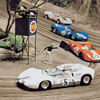Formula 2 Sidecar Outfit:Parts1 ,2 and3
30 posts
• Page 1 of 2 • 1, 2
Formula 2 Sidecar Outfit:Parts1 ,2 and3
Last edited by Wolseley Hornet on Sat Apr 11, 2015 9:02 am, edited 2 times in total.
-

Wolseley Hornet - HRW SlotCar Veteran!
- Posts: 669
- Joined: Wed Sep 05, 2012 4:25 pm
- Location: East Riding of Yorkshire. UK.
Re: Formula 2 Sidecar Outfit:Part1
Wow. You are fearless in your selection of projects! What will you use for material on the body?
-

waaytoomuchintothis - "Seasoned SlotRacer"
- Posts: 7576
- Joined: Wed Aug 29, 2012 7:16 pm
- Location: Chesterfield, Virginia
Re: Formula 2 Sidecar Outfit:Part1
That is pretty darn cool and I imagine having a couple of those going up against one another would be a LOT of fun!
Thanks for sharing "Part 1"! :)
Thanks for sharing "Part 1"! :)
-

TuscoTodd - HRW Bouncer
- Posts: 7145
- Joined: Sat Aug 17, 2013 11:25 am
- Location: Rural Ohio
-

Wolseley Hornet - HRW SlotCar Veteran!
- Posts: 669
- Joined: Wed Sep 05, 2012 4:25 pm
- Location: East Riding of Yorkshire. UK.
Re: Formula 2 Sidecar Outfit:Part1
That is going to be really cool!
- Lou E
- HRW SlotCar Veteran!
- Posts: 325
- Joined: Mon Oct 08, 2012 9:41 pm
- Location: Freehold, NJ
Re: Formula 2 Sidecar Outfit:Part1
Love that....you have created a beautiful chassis there. I look forward to seeing how the body work goes. I would recommend a resin body....but I would wouldn't I?
-

munter - HRW SlotCar Veteran!
- Posts: 1014
- Joined: Thu May 16, 2013 11:18 am
- Location: New Zealand
Re: Formula 2 Sidecar Outfit:Part1
I have several of the newer Scaley outfits, I wonder if you could use their body?
-

Alaskaracer - HRW SlotCar Veteran!
- Posts: 195
- Joined: Wed Sep 05, 2012 4:08 pm
- Location: Howey In the Hills, FL
Re: Formula 2 Sidecar Outfit:Part 2
Well, we've got a chassis that works.
Now for the body . . .
Initial outline drawing photocopied, and glued to a lump of balsa, and roughly cut out:

Then some sanding:

. . . and more sanding,until it starts to look about right:
 .
.
At this stage, I'm starting to wonder if the mechanism will fit inside it, so decided a quick resin cast would be in order:

Everything fits, but I made the mistake of trying out some colouring pigment. Looks nice, but what messy stuff! Think photocopier toner - only worse! I'm still getting a tiny spill off my hands - it gets down the sides of your nails, and quite honestly, I think you have to wait until it grows out.
The other problem is with a dense black shell, you can't see inside well enough to gauge how much more material you can remove.
So I did another one with straight resin:

and looked at it alongside Scalextric's offerings.
So far, so good.There followed a long spell of further sanding and shaping of the master, to reduce the overall size(these things are TINY), and get
rid of the woodgrain effect.At first I used coat after coat of cellulose-based sanding sealer(plenty of fresh air required - you can feel this stuff dissolving your brain), then filler primer, then automotive gloss, until:

This looked good enough to make another mould.
A big difficulty, I've found, is that when your eye is tuned to one scale(1/32), it's difficult to maintain a sense of proportion in another.
It helps to have a figure to put alongside the model:

The standing figure is from a 1/24 railway range, and gives a better idea of the sidecar's size.
If anything, it's still a bit bulky, but it gives the flavour of the original and I think I'll get it all working before refining it further.
. . . to be continued.
David.
Now for the body . . .
Initial outline drawing photocopied, and glued to a lump of balsa, and roughly cut out:

Then some sanding:

. . . and more sanding,until it starts to look about right:
 .
.At this stage, I'm starting to wonder if the mechanism will fit inside it, so decided a quick resin cast would be in order:

Everything fits, but I made the mistake of trying out some colouring pigment. Looks nice, but what messy stuff! Think photocopier toner - only worse! I'm still getting a tiny spill off my hands - it gets down the sides of your nails, and quite honestly, I think you have to wait until it grows out.
The other problem is with a dense black shell, you can't see inside well enough to gauge how much more material you can remove.
So I did another one with straight resin:

and looked at it alongside Scalextric's offerings.
So far, so good.There followed a long spell of further sanding and shaping of the master, to reduce the overall size(these things are TINY), and get
rid of the woodgrain effect.At first I used coat after coat of cellulose-based sanding sealer(plenty of fresh air required - you can feel this stuff dissolving your brain), then filler primer, then automotive gloss, until:

This looked good enough to make another mould.
A big difficulty, I've found, is that when your eye is tuned to one scale(1/32), it's difficult to maintain a sense of proportion in another.
It helps to have a figure to put alongside the model:

The standing figure is from a 1/24 railway range, and gives a better idea of the sidecar's size.
If anything, it's still a bit bulky, but it gives the flavour of the original and I think I'll get it all working before refining it further.
. . . to be continued.
David.
-

Wolseley Hornet - HRW SlotCar Veteran!
- Posts: 669
- Joined: Wed Sep 05, 2012 4:25 pm
- Location: East Riding of Yorkshire. UK.
Re: Formula 2 Sidecar Outfit:Part1
Impressive and cool....I like what you have done very much.
-

munter - HRW SlotCar Veteran!
- Posts: 1014
- Joined: Thu May 16, 2013 11:18 am
- Location: New Zealand
Re: Formula 2 Sidecar Outfit:Part1
Wow! That is shaping up nice!
VERY cool approach to making these - any chance of this developing into a fun run proxy?
(would be awesome to see a whole field of these together!) :D
VERY cool approach to making these - any chance of this developing into a fun run proxy?
(would be awesome to see a whole field of these together!) :D
-

TuscoTodd - HRW Bouncer
- Posts: 7145
- Joined: Sat Aug 17, 2013 11:25 am
- Location: Rural Ohio
Re: Formula 2 Sidecar Outfit:Parts1 and 2
Thanks for the kind remarks.
I'm looking on this as a developing project. Although the chassis works, it is a bit flimsy and light, and I'm considering trying to make it with PCB,and the wheel and motor bearings soldered on - just to give a bit more low-down weight.
The challenge that will make or break it is going to be modelling the crew in a reproducible way, as the human figures are such a crucial part of the way these sidecars look. Once this is sorted out, and I have a reliable chassis, it won't be too difficult to produce a variety of body styles.
And yes, TuscoTodd, wouldn't a whole field of these on a big track look great!
David.
I'm looking on this as a developing project. Although the chassis works, it is a bit flimsy and light, and I'm considering trying to make it with PCB,and the wheel and motor bearings soldered on - just to give a bit more low-down weight.
The challenge that will make or break it is going to be modelling the crew in a reproducible way, as the human figures are such a crucial part of the way these sidecars look. Once this is sorted out, and I have a reliable chassis, it won't be too difficult to produce a variety of body styles.
And yes, TuscoTodd, wouldn't a whole field of these on a big track look great!
David.
-

Wolseley Hornet - HRW SlotCar Veteran!
- Posts: 669
- Joined: Wed Sep 05, 2012 4:25 pm
- Location: East Riding of Yorkshire. UK.
Re: Formula 2 Sidecar Outfit:Parts1 and 2
Wow, that looks awesome, going to have to research those real ones
-

MichiganCur - HRW SlotCar Veteran!
- Posts: 138
- Joined: Sat Apr 04, 2015 12:47 pm
- Location: Northern Michigan
Re: Formula 2 Sidecar Outfit:Parts1 and 2
That is looking awesome! Love to have a few when you cast them.
-

Alaskaracer - HRW SlotCar Veteran!
- Posts: 195
- Joined: Wed Sep 05, 2012 4:08 pm
- Location: Howey In the Hills, FL
Re: Formula 2 Sidecar Outfit:Parts1 and 2
This is great - chasing down a unique and unusual subject with a full-on *scratchbuilt* effort.
The vintage Ulrich "Mini-Men" may be useful for 'posable' 1/24 figures, but there are more modern approaches - one of course involving 3d printing of the figures...
Anyway, this build thread shows that anything can be done, inspiring and instructional - great thread.
Thanks.
The vintage Ulrich "Mini-Men" may be useful for 'posable' 1/24 figures, but there are more modern approaches - one of course involving 3d printing of the figures...
Anyway, this build thread shows that anything can be done, inspiring and instructional - great thread.
Thanks.
-

Vintage 1/24 - Mr. NY Modified
- Posts: 505
- Joined: Thu Sep 06, 2012 8:40 am
- Location: Long Island, NY
-

Wolseley Hornet - HRW SlotCar Veteran!
- Posts: 669
- Joined: Wed Sep 05, 2012 4:25 pm
- Location: East Riding of Yorkshire. UK.
30 posts
• Page 1 of 2 • 1, 2
Return to The Marty Stanley Scratchbuilders Shop
Who is online
Users browsing this forum: No registered users and 5 guests
